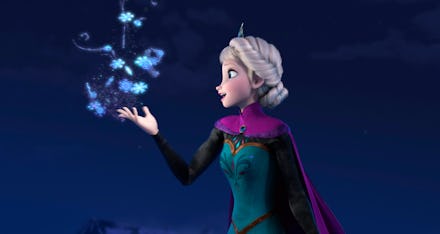How the White, Blonde Disney Princesses Sell vs. Dark-Skinned Ones

Does being the fairest of them all still make you the most popular?
According to a new chart that maps Disney princess skin tone and hair against merchandise sales, it appears that may be the case.
Dadaviz's Jody Sieradzki used a report by Terapeak, which compared eBay sales of Disney princess merchandise for the past 18 months, to create the data visualization chart. What she found is that sales lagged for princesses of color, but soared for those with the lightest skin and hair.
Case in point: Frozen's Elsa, quite literally the whitest of all princesses, has raked in nearly $3.4 million, while The Princess and the Frog's Tiana and Aladdin's Jasmine fell far behind everyone else, with one exception: Beauty and the Beast's Belle, a white brunette.
At first glance, it seems like Disney connoisseurs just have racially based preferences. But while there's certainly a strong correlation between the princesses' looks and sales, the data does not definitively prove that looks cause high or low sales.
"There are multiple factors to weigh before determining whether or not these sales numbers are simply caused by the skin/hair color of the Disney characters, one being timing," Sieradzki told Mic in an email interview. "Frozen is the most recent Disney sensation, thus larger merchandise sales for the characters Elsa and Anna makes sense."
While that may be true, timing doesn't explain the rest of the princess's popularity. Cinderella and Snow White, for example, are staples in the Disney princess trove, yet continue to perform extremely well on the eBay market.
"Another factor is the overall popularity of the Disney movie," Sieradzki said. "The movie The Princess and the Frog didn't do well in theaters, so I wouldn't expect [Tiana] merchandise sales to do well either. But I guess one would have to question why this movie did not do as well as other Disney movies."
In other words, how much effort did Disney put into the marketing and promotion of a movie that centers on a princess of color?
Disney critics have long accused the company of racism and heterogeneity, and while the media powerhouse has made recent strides in diversifying its princesses, perhaps it's not doing enough on the merchandise front. Did Disney manufacture equal shares of white versus non-white princess wares? Considering that two other princesses of color, Mulan and Pocahontas, didn't even rank in the report, it's an alarming possibility.
The trends this chart reveals certainly raise questions, and point to an equally disquieting potential outcome: If merchandise of princesses of color continues to fare poorly, will Disney discontinue marketing them altogether or scrap future plans for movies centered on diverse characters?
We hope not. It would be unfortunate if toy sales were prioritized over giving children varied role models they can look up to.